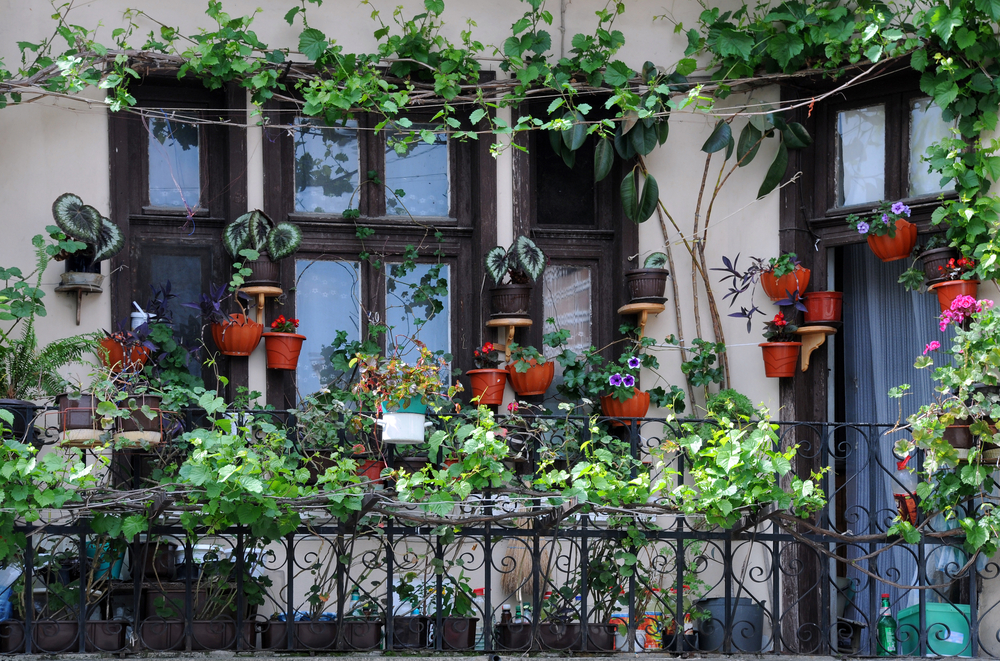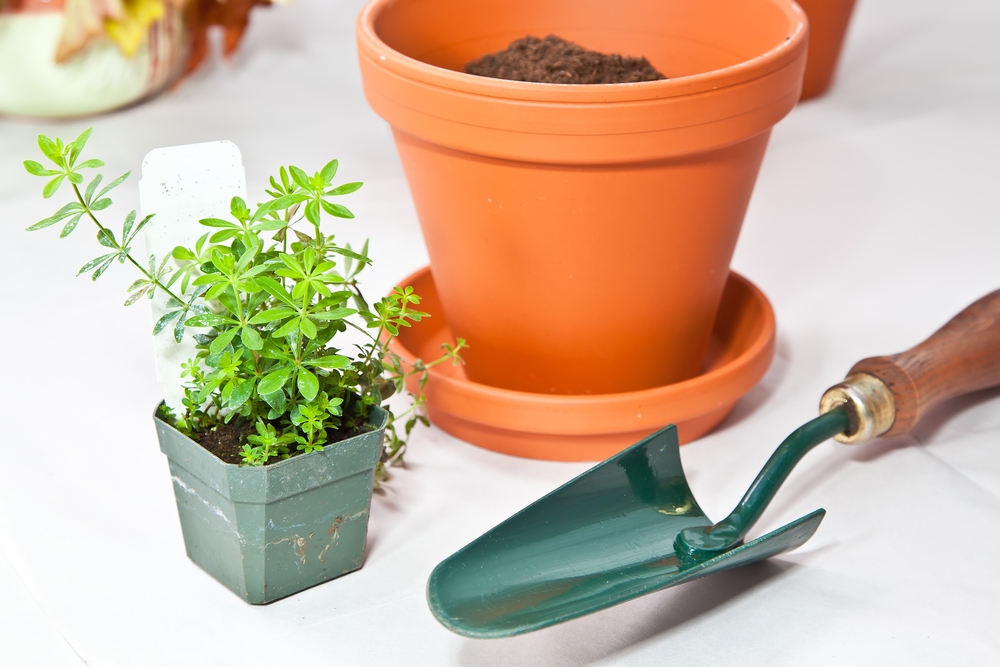Not everyone has room for a full garden, but did you know you can still grow some of your own food with limited space?
Here’s your guide to a quick and easy balcony garden. You can even grow your food in the city and make some extra room in your budget.
What Can Your Balcony Garden Grow?
In general, herbs are relatively easy to grow and plants that have vines take up little space because they can grow vertically. Here are some of the plants that are most likely to grow easily on a balcony:
- Cucumbers
- Tomatoes
- Peppers
- Zucchini
- Summer squash
- Celery
- Lots of greens (lettuce, kale, mustard’s, spinach, bok choy, etc)
- Broccoli
- Mint
- Rosemary
- Cilantro
- Lavender
- Parsley
- Basil
- Tarragon
- Radishes
- Spring onions
Herbs tend to like full or partial sunlight (at least four hours), so consider positioning them on the sunniest part of your balcony. You could also keep them inside by a window and leave the balcony for the plants that require bigger pots and a little bit more space.
Most greens, on the other hand, can thrive in the shade, as can root vegetables.
Before You Get Started
Before you plant your seeds and put them outside, find out if it’s a good idea to start the seedlings inside and then transfer them to the balcony. Balcony Container Gardening has a good guide for this.
Calculate the Amount of Sun Your Balcony Gets
If your balcony gets six or more hours of sun (referred to as full sun), you’re in luck and you’ll be able to grow quite a variety of plants. Three to six hours qualifies as partial sun and 1.5 to four hours is considered partial shade. Anything less than three hours is considered full shade.
If the sunlight isn’t direct and it’s coming through tree leaves or it’s obstructed in some other similar way, it’s filtered (or dappled) light. There are products, like the SunCalc, that can help you determine exactly how much light your balcony gets in a day.
Seed packets will generally tell you the amount of sunlight necessary for a plant to grow and thrive. You’ll also see ideal climate information.
These bits of information will allow you to piece together a garden that works where you live (and may even drive your decision when you begin looking for another home, if being able to grow certain types of your own food is especially important to you).
Decide How Much Time You Have
How do the watering and fertilizing requirements combined with any pruning needs for the foods you hope to grow compare to the amount of time you want to spend on your garden?
For example, if you have a very hot, sunny balcony, will you want to water especially thirsty plants twice a day?
No matter how committed you plan to be to your garden, it’s smart to start small. You’ll be less likely to get overwhelmed by the maintenance and get a true feel for how much you enjoy tending a garden before you devote too much money or energy to it.
What’s the Climate Like?
The climate on your balcony may not be the same as the climate on the ground. Is it windier? Shadier? Hotter or colder? Factor these things in when choosing your plants.
You may need hardier plants to withstand the wind that whips through at your apartment’s height, for example. Burpee’s Growing Zone Location map is a good place to start.
Ask If You’re Allowed to Have a Garden
If you’ve got the space and the sunlight for what you want to grow, there’s one more thing you should check before you get started—whether you’re allowed to have a balcony garden at all.
Check in with the management office or landlord where you live and find out if there are any rules against having a garden on your balcony.
Nothing would be more disappointing than getting everything set up only to find out that you had to get rid of it.
What You Need, Other Than the Seeds
- Pots, appropriately sized for the amount of root space the plants will need
- Materials for vines to climb
- Hanging baskets or troughs (optional, but they can help utilize your space since they won’t be on the floor)
- Gloves for keeping your hands clean and unscratched
- Trowel for digging
- Watering can (the more plants you have and the more water they need, the bigger the watering can should be so you can be more efficient)
- Soil
- Organic fertilizer
In some cases, you don’t even need seeds. Take a look at Black Thumb Gardener’s post on plants you can grow from kitchen scraps.
The Layout of the Garden
The layout of your garden will ultimately depend on where the sunniest spots are, how much furniture you have on the balcony, how much space you need for entertaining guests, and how you can arrange your containers in a way that allows you to still walk around and water them with ease.
Another tip is to layer your plants with the tallest toward the back, near a wall, with the shorter ones in front. It’s easier to water them and more aesthetically pleasing.
Planting Your Fruits and Veggies
- Always arrange your containers before you pour the soil. They’re much lighter and easier to move that way.
- Pour in your organic potting soil and mix in a little organic fertilizer.
- Plant your seeds or seedlings only as far down in the soil as recommended.
- Add more soil around the base of the seedlings if necessary, once all the plants are in place.
- Add water until the soil is wet, but not completely saturated, and be sure to keep the water off the leaves as the plants grow.
The Importance of Planning
Planning ahead is perhaps the most important tip in your guide to a quick and easy balcony garden. You’ll need to take space and the amount of sunlight the area gets, of course, but you should be realistic about how much time and energy you want to commit to your garden so you’re not disappointed or overwhelmed.
Instead, you can celebrate your health and the delicious food you’re growing right outside your door!
Finally, before we wrap up this post, I’m curious:
Do you currently have plants at home? Which are your favorite plant varieties?
We’d love to know more about your garden and the plants you have, please share below!
Thanks so much and Happy Planting! :)
Love,
Kimberly
12 Comments
Trackbacks/Pingbacks
- How to turn your balcony into a jungle with these amazing plants - […] you heard of urban gardening? You can grow vegetables even in tiny plots on balconies and terraces, with just…




I love lavender and add a new variety to one area each year.
I love herbs (thyme-lemon and regular, rosemary, lemon basil), cilantro and tomatoes.
Wow, that’s a good and interesting idea. I too have many plants on my balcony, I have planted about 10 herbs and flowers till now.
I can never have too many! ;) Lots of love and support to you Irving Aponte!
hello yes I have. but im planning on how to make it better esp the placement of some other stuff that I will use to recycle.
This was very helpful in helping me start my new balcony garden especially since I’ve never grown anything. Thank you
So happy to hear this post helped you out, and that you have your very own balcony garden now. Sending you lots of love and continued support! Happy Gardening! ;)
Good article & excellent way to articulate. Keep it up.
Thanks so much Fancy Plants Nursery! Lots of love! ;)
I want to create terrace garden in my house. it is my own house. terrace got 1200 SQ feet
Hi Jothi! That sounds amazing! You’ll be able to grow so many beautiful fruits, veggies and herbs. Good luck! xx
This is a very interesting article! Thanks for sharing much information
Lots of love to you Arthur! Xo